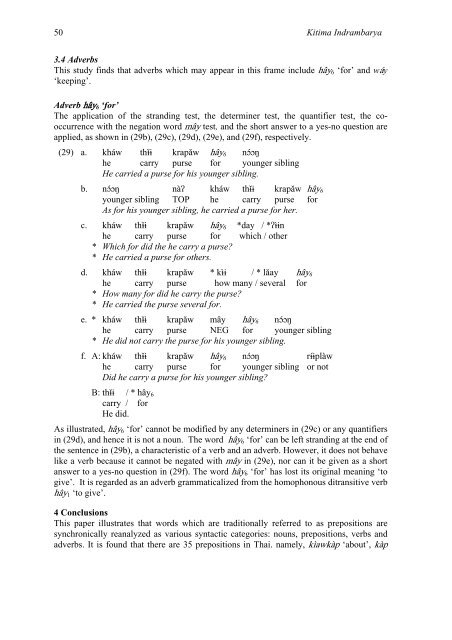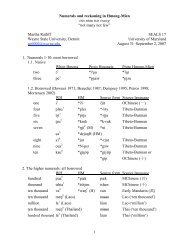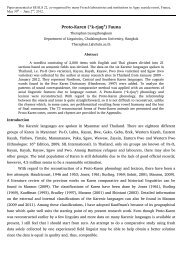proto-southwestern-tai revised: a new reconstruction - seals 22
proto-southwestern-tai revised: a new reconstruction - seals 22
proto-southwestern-tai revised: a new reconstruction - seals 22
Create successful ePaper yourself
Turn your PDF publications into a flip-book with our unique Google optimized e-Paper software.
50 Kitima Indrambarya<br />
3.4 Adverbs<br />
This study finds that adverbs which may appear in this frame include hây6 ‘for’ and wáy<br />
‘keeping’.<br />
Adverb hây6 ‘for’<br />
The application of the stranding test, the determiner test, the quantifier test, the cooccurrence<br />
with the negation word mây test, and the short answer to a yes-no question are<br />
applied, as shown in (29b), (29c), (29d), (29e), and (29f), respectively.<br />
(29) a. kháw thɨ̌ɨ krapǎw hây6 nɔ́ɔŋ<br />
he carry purse for younger sibling<br />
He carried a purse for his younger sibling.<br />
b. nɔ́ɔŋ nàʔ kháw thɨ̌ɨ krapǎw hây6<br />
younger sibling TOP he carry purse for<br />
As for his younger sibling, he carried a purse for her.<br />
c. kháw thɨ̌ɨ krapǎw hây6 *day / *ʔɨ̀ɨn<br />
he carry purse for which / other<br />
* Which for did the he carry a purse?<br />
* He carried a purse for others.<br />
d. kháw thɨ̌ɨ krapǎw * kɨ̀ɨ / * lǎay hây6<br />
he carry purse how many / several for<br />
* How many for did he carry the purse?<br />
* He carried the purse several for.<br />
e. * kháw thɨ̌ɨ krapǎw mây hây6 nɔ́ɔŋ<br />
he carry purse NEG for younger sibling<br />
* He did not carry the purse for his younger sibling.<br />
f. A: kháw thɨ̌ɨ krapǎw hây6 nɔ́ɔŋ rɨ́ɨplàw<br />
he carry purse for younger sibling or not<br />
Did he carry a purse for his younger sibling?<br />
B: thɨ̌ɨ / * hây6<br />
carry / for<br />
He did.<br />
As illustrated, hây6 ‘for’ cannot be modified by any determiners in (29c) or any quantifiers<br />
in (29d), and hence it is not a noun. The word hây6 ‘for’ can be left stranding at the end of<br />
the sentence in (29b), a characteristic of a verb and an adverb. However, it does not behave<br />
like a verb because it cannot be negated with mây in (29e), nor can it be given as a short<br />
answer to a yes-no question in (29f). The word hây6 ‘for’ has lost its original meaning ‘to<br />
give’. It is regarded as an adverb grammaticalized from the homophonous ditransitive verb<br />
hây1 ‘to give’.<br />
4 Conclusions<br />
This paper illustrates that words which are traditionally referred to as prepositions are<br />
synchronically reanalyzed as various syntactic categories: nouns, prepositions, verbs and<br />
adverbs. It is found that there are 35 prepositions in Thai. namely, kìawkàp ‘about’, kàp





